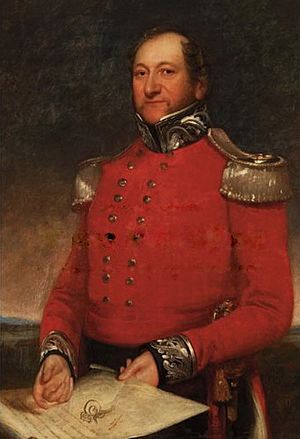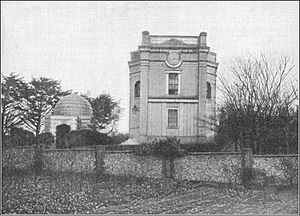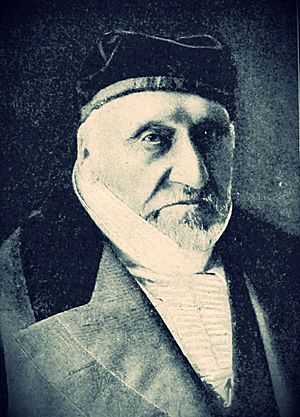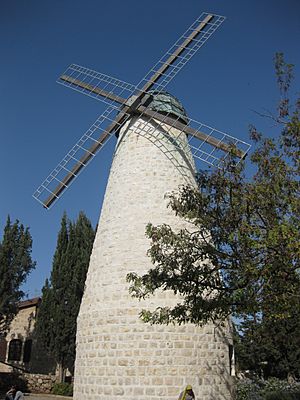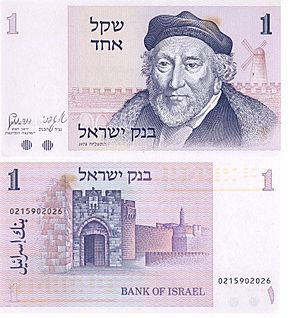Moses Montefiore facts for kids
Quick facts for kids
Moses Montefiore
|
|
|---|---|
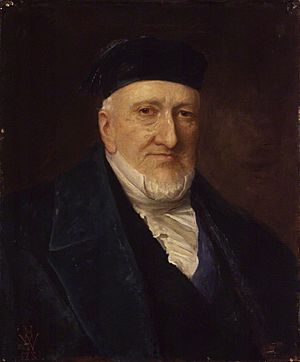
Sir Moses Montefiore painted in 1881
|
|
| President of the Board of Deputies of British Jews | |
| In office 1835–1838 |
|
| Preceded by | Moses Mocatta |
| Succeeded by | David Salmons |
| Personal details | |
| Born | 24 October 1784 Livorno, Grand Duchy of Tuscany |
| Died | 28 July 1885 (aged 100) Ramsgate, Kent, England |
| Spouse |
Judith Barent Cohen
(m. 1812) |
| Parents | Joseph Elias Montefiore Rachel Mocatta |
| Relatives | Abraham Mocatta (maternal grandfather) Joshua Montefiore (paternal uncle) Levy Barent Cohen (father-in-law) |
| Occupation | Banker |
Sir Moses Haim Montefiore (born October 24, 1784 – died July 28, 1885) was a very important British businessman, banker, and someone who loved to help others. He was also a Sheriff of London. He came from an Italian Jewish family in London. After becoming very successful and wealthy, he gave a lot of his money to help Jewish communities in the Levant (which is the eastern Mediterranean region, including places like Israel, Syria, and Lebanon).
He helped build businesses, improve education, and provide healthcare. In 1860, he started Mishkenot Sha'ananim, which was the first Jewish neighborhood built outside the old walls of Jerusalem. He also led the Board of Deputies of British Jews for many years. His work is seen as a key part of the early ideas that led to Proto-Zionism, a movement supporting a Jewish homeland.
Contents
Early Life and Family
Moses Montefiore was born in 1784 in Livorno, a city in Tuscany, Italy. His family was Sephardic Jewish, which means they were Jews whose ancestors came from Spain and Portugal. Even though his family lived in Great Britain, his grandfather, Moses Vital Montefiore, kept strong ties with Livorno. Moses was born there because his parents, Joseph Elias Montefiore and Rachel Mocatta, were on a business trip. Rachel's father, Abraham Mocatta, was a powerful broker in London who dealt with precious metals like gold and silver.
Moses Montefiore's Career
After Moses was born, his family moved back to Kennington in London. Moses went to school there, but his family needed money, so he had to leave school early to help out. He first worked for a tea merchant and then for a financial office in the City of London. In 1803, he started working at the London Stock Exchange, which is where people buy and sell shares of companies. However, he lost all his clients' money in 1806 because of a fraud. This meant he probably had to stop being a stockbroker for a while.
In 1812, Moses Montefiore joined the Freemasons, a social and charitable organization. He also served in the Surrey Militia, a local army group, from 1810 to 1814. In 1815, he got his broker's license back and worked with his brother for a short time. By 1820, he mostly stopped his trading work.
In 1812, Moses married Judith Cohen. Her sister, Henriette, was married to Nathan Mayer Rothschild, who ran a very famous banking business in Britain. Moses Montefiore's company worked as stockbrokers for Nathan Rothschild, and the two brothers-in-law became business partners. Moses was very creative in business. He invested in new ideas, like bringing piped gas for street lighting to European cities. He also helped start the Alliance Assurance Company in 1824, which was an insurance company.
Even though he wasn't very religious when he was younger, everything changed after he visited the Holy Land in 1827. After that trip, Moses became a very religious Jew. He even traveled with his own shohet (a person who prepares kosher meat according to Jewish law) so he could always eat kosher food. This visit was a "spiritual transforming event" for him. He decided to follow Jewish laws more closely and go to synagogue regularly.
In 1831, Moses bought a large country home in Ramsgate, a popular seaside town. The property used to belong to Queen Caroline. Soon after, he bought more land next to it and asked his cousin, architect David Mocatta, to design a private synagogue. This synagogue, called the Montefiore Synagogue, opened in 1833 with a big ceremony.
Moses Montefiore was a well-known figure. He is mentioned in the writings of famous authors like Charles Dickens and George Eliot. He worked with many social reformers in Victorian England to help minorities and fight against slavery. In 1835, a loan arranged by the Rothschilds and Montefiore helped the British government pay slave owners so that slavery could be ended across the British Empire.
In 1837, Moses Montefiore was elected Sheriff of the City of London. He was also given the title of Knight in November 1837, which means he could be called "Sir."
Later Life and Helping Others
After he stopped working in business, Moses Montefiore spent the rest of his life helping others. This is called philanthropy. He was the president of the Board of Deputies of British Jews for 39 years, from 1835 to 1874, which is the longest anyone has ever held that position.
He dedicated himself to helping Jewish people who were suffering in other countries. For example, in 1840, he went to the sultan of the Ottoman Empire to help free ten Syrian Jews who were wrongly arrested in a case called the Damascus affair. In 1858, he went to Rome to try to free a Jewish boy named Edgardo Mortara, who had been taken by the Catholic Church. He also traveled to Russia in 1846 and 1872, to Morocco in 1864, and to Romania in 1867. These trips made him a hero to many Jewish people who were being treated unfairly in Eastern Europe, North Africa, and the Middle East.
In 1846, he was given the title of baronet (Sir Moses Montefiore, 1st Baronet) because of all his good work helping people.
Helping in Ottoman Palestine
In 1836, Moses and his wife, Judith, traveled to Palestine after a big earthquake damaged towns like Safed and Tiberias. They started a large relief program in 1837 to help the survivors.
In 1854, his American friend, Judah Touro, who was also a Sephardic Jew, passed away. Judah left money to help Jewish people settle in Palestine. Moses was put in charge of this money. He used it for many projects to help Jews learn useful skills and find work. In 1855, he bought an orchard near Jaffa to teach Jews about farming.
In 1860, he built the first Jewish neighborhood outside the old walls of Jerusalem. This area is now known as Mishkenot Sha'ananim. It was dangerous to live outside the city walls back then because of crime. So, Moses offered money to encourage poor families to move there. He wanted Mishkenot Sha'ananim to be a clean, self-sufficient place where both Sephardic Jews and Ashkenazi Jews could live together. Later, he built other neighborhoods nearby, like Ohel Moshe for Sephardic Jews and Mazkeret Moshe for Ashkenazi Jews, who had different traditions.
Moses Montefiore gave a lot of money to help Jewish communities in Palestine with business, education, and health. He wanted to help the Jewish people become self-supporting. He even brought builders from England for his projects.
He built the Montefiore Windmill in what is now the Yemin Moshe neighborhood. This windmill helped provide cheap flour to poor Jews. He also started a printing press and a textile factory. The Jewish people in Palestine called him "ha-Sar Montefiore," which means 'The Prince' Montefiore, because he helped them so much.
Moses also ordered several counts of the Jewish community in Palestine in 1839, 1849, 1855, 1866, and 1875. These counts collected information about families, where they came from, and how poor they were.
Later Years and Passing
Moses Montefiore was very involved in the town of Ramsgate. In 1845, he served as High Sheriff of Kent. In 1873, when he was 89, a local newspaper mistakenly printed his obituary (a notice of his death). He wrote to the editor, saying he was thankful to hear the rumor and read about it with his own eyes!
The town celebrated his 99th and 100th birthdays in a big way. He gave money to almost every local charity and church. After his wife Judith passed away in 1862, he built a Sephardic yeshiva (a Jewish school) called Judith Lady Montefiore College on his estate. He also built the beautiful Montefiore Synagogue and a mausoleum (a building for a tomb) that looked like Rachel's Tomb in Bethlehem. Judith was buried there in 1862.
Sir Moses Montefiore passed away in 1885, at the amazing age of 100 years and 9 months. He did not have any known children. His main heir was his nephew, Sir Joseph Sebag-Montefiore.
The Montefiore estate in Ramsgate was sold around 1952, and his main house was taken down in 1954. Today, only some parts of the original buildings remain, like the Coach House and the Gate House. The beautiful Italianate Greenhouse has been restored. The estate is now part of King George VI Memorial Park, and a plaque honors Sir Moses.
His Legacy
Many places are named after Sir Moses Montefiore because of his important work:
- The Montefiore Home for Chronic Invalids and the Montefiore Medical Center in New York, USA.
- Montefiore Square, a small park in Hamilton Heights, New York.
- A branch of the University of Pittsburgh Medical Center in Pittsburgh, Pennsylvania, USA.
- Moses Montefiore Academy, a school in Chicago, USA.
- Several synagogues, including the 1913 Montefiore Institute in Canada, now known as the Little Synagogue on the Prairie.
- The Montefiore Club, a private social and business club for the Jewish community in Montreal, Quebec, Canada.
- A Jewish nursing home in Cleveland, Ohio, USA.
He was even featured on two Israeli banknotes: the IL10 (from 1970–79) and the IS 1 (from 1980 to 1986). The Jewish cemetery in Dublin, Ireland, is also dedicated to him.
A Famous Story
Moses Montefiore was known for being very clever and quick-witted. There's a popular story, which might not be entirely true, that he was once at a dinner party sitting next to a nobleman who disliked Jewish people. The nobleman told Montefiore that he had just returned from a trip to Japan, where "they have neither pigs nor Jews." Montefiore is said to have replied right away, "In that case, you and I should go there, so it will have a sample of each!"
Images for kids
See also
- History of the Jews in England
- Mazkeret Moshe, Zikhron Moshe, Kiryat Moshe and Yemin Moshe, neighborhoods in Jerusalem which bear his name
- Montefiore, Tel Aviv, another neighborhood named after him
- Montefiore Windmill, windmill in Jerusalem, erected due to Montefiore
- Isaac Leib Goldberg (1860–1935), Zionist leader and philanthropist from Russia
- Maurice de Hirsch (1831–1896), German Jewish financier and philanthropist, founder of the Jewish Colonization Association
- Edmond James de Rothschild (1845–1934), French Jewish banker and major donor of the Zionist project


